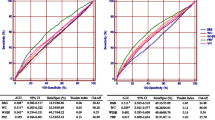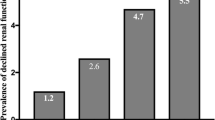Abstract
Background
This study was conducted to assess gender difference in the association of chronic kidney disease (CKD) with visceral adiposity index (VAI) and lipid accumulation product index (LAP) in Korean adults.
Materials and methods
The study was performed using data from the 2015 Korean National Health and Nutrition Examination Survey and included 4947 adults aged 20 years or older.
Results
There were several key findings in the present study. First, overall, after adjusting for related variables (including age), CKD (estimated glomerular filtration rate < 60 ml/min/1.73 m2) was positively associated with the quartiles of VAI and LAP. Second, when analyzed separately for gender, the results in men and women were different. After adjusting for the related variables (except age), CKD was positively associated with the quartiles of VAI and LAP in both men and women. After further adjustment for age, CKD was still positively associated with the quartiles of VAI and LAP in men. However, in women, the relationships between CKD and the quartiles of VAI and LAP were no longer significant.
Conclusions
The VAI and LAP index were positively associated with CKD in Korean men but not in women.


Similar content being viewed by others
References
Matsushita K, Ballew SH, Coresh J (2016) Cardiovascular risk prediction in people with chronic kidney disease. Curr Opin Nephrol Hypertens 25:518–523
Mehta RL, Cerdá J, Burdmann EA et al (2015) International Society of Nephrology’s 0by25 initiative for acute kidney injury (zero preventable deaths by 2025): a human rights case for nephrology. Lancet 385:2616–2643
Wang H, Naghavi M, Allen C et al (2016) GBD 2015 Mortality and Causes of Death Collaborators. Global, regional, and national life expectancy, all-cause mortality, and cause-specific mortality for 249 causes of death, 1980–2015: a systematic analysis for the Global Burden of Disease Study 2015. Lancet 388:1459–1544
Kassebaum NJ, Arora M, Barber RM et al (2016) GBD 2015 DALYs and HALE Collaborators. Global, regional, and national disability-adjusted life-years (DALYs) for 315 diseases and injuries and healthy life expectancy (HALE), 1990–2015: a systematic analysis for the Global Burden of Disease Study 2015. Lancet 388:1603–1658
Bulbul MC, Dagel T, Afsar B et al (2018) Disorders of lipid metabolism in chronic kidney disease. Blood Purif 46:144–152
Barbara PV, Jacqueline CTC (2017) Recognition of visceral obesity beyond body fat: assessment of cardiovascular risk in chronic kidney disease using anthropometry. Nutrire 42:19. https://doi.org/10.1186/s41110-017-0041-2
de Mutsert R, Grootendorst DC, Axelsson J et al (2008) Excess mortality due to interaction between protein-energy wasting, inflammation and cardiovascular disease in chronic dialysis patients. Nephrol Dial Transpl 23:2957–2964
Annuk M, Soveri I, Zilmer M, Lind L, Hulthe J, Fellström B (2005) Endothelial function, CRP and oxidative stress in chronic kidney disease. J Nephrol 18:721–726
Moe S, Drüeke T, Cunningham J et al (2006) Kidney Disease: improving global outcomes (KDIGO). Definition, evaluation, and classification of renal osteodystrophy: a position statement from kidney disease: improving global outcomes (KDIGO). Kidney Int 69:1945–1953
Vickery S, Webb MC, Price CP, John RI, Abbas NA, Lamb EJ (2008) Prognostic value of cardiac biomarkers for death in a nondialysis chronic kidney disease population. Nephrol Dial Transpl 23:3546–3553
Xu X, Zhao Y, Zhao Z et al (2016) Correlation of visceral adiposity index with chronic kidney disease in the People’s Republic of China: to rediscover the new clinical potential of an old indicator for visceral obesity. Ther Clin Risk Manag 12:489–494
Makki K, Froguel P, Wolowczuk I (2013) Adipose tissue in obesity-related inflammation and insulin resistance: cells, cytokines, and chemokines. ISRN Inflamm 2013:139239. https://doi.org/10.1155/2013/139239
Nieves DJ, Cnop M, Retzlaff B, Walden CE, Brunzell JD, Knopp RH, Kahn SE (2003) The atherogenic lipoprotein profile associated with obesity and insulin resistance is largely attributable to intraabdominal fat. Diabetes 52:172–179
Amato MC, Giordano C, Galia M et al (2010) Visceral adiposity index: a reliable indicator of visceral fat function associated with cardiometabolic risk. Diabetes Care 33:920–922
Kahn HS (2005) The “lipid accumulation product” performs better than the body mass index for recognizing cardiovascular risk: a population-based comparison. BMC Cardiovasc Disord 5:26. https://doi.org/10.1186/1471-2261-5-26
Tavern MJ, Martinez-larrad MT, Frechtel GD et al (2011) Lipid accumulation product: A powerful marker of metabolic syndrome in healthy population. Eur J Endocrinol 164:559–567
Roriz AK, Passos LC, de Oliveira CC, Eickemberg M, Moreira Pde A, Sampaio LR (2014) Evaluation of the accuracy of anthropometric clinical indicators of visceral fat in adults and elderly. PLoS ONE 9:e103499. https://doi.org/10.1371/journal.pone.0103499
Oh JY, Sung YA, Lee HJ (2013) The lipid accumulation product as a useful index for identifying abnormal glucose regulation in young Korean women. Diabet Med 30:436–442
Ioachimescu AG, Brennan DM, Hoar BM, Hoogwerf BJ (2010) The lipid accumulation product and all-cause mortality in patients at high cardiovascular risk: a PreCIS database study. Obesity 18:1836–1844
Amato MC, Giordano C (2014) Visceral adiposity index: an indicator of adipose tissue dysfunction. Int J Endocrinol 2014:730827. https://doi.org/10.1155/2014/730827
Chen YC, Lai SH, Tsai YW, Chang SS (2018) Visceral Adiposity Index as a predictor of chronic kidney disease in a relatively healthy population in Taiwan. J Ren Nutr 28:91–100
Mousapour P, Barzin M, Valizadeh M, Mahdavi M, Azizi F, Hosseinpanah F (2019) Predictive performance of lipid accumulation product and visceral adiposity index for renal function decline in non-diabetic adults, an 86-year follow-up. Clin Exp Nephrol. https://doi.org/10.1007/s10157-019-01813-7
Dai D, Chang Y, Chen Y et al (2016) Visceral adiposity index and lipid accumulation product index: two alternate body indices to identify chronic kidney disease among the rural population in Northeast China. Int J Environ Res Public Health 13:E1231. https://doi.org/10.3390/ijerph13121231
Wolf G, Ziyadeh FN (2006) Leptin and renal fibrosis. Contrib Nephrol 151:175–183
Ellington AA, Malik AR, Klee GG et al (2007) Association of plasma resistin with glomerular filtration rate and albuminuria in hypertensive adults. Hypertension 50:708–714
Ruster C, Wolf G (2013) The role of the renin-angiotensin-aldosterone system in obesity-related renal diseases. Semin Nephrol 33:44–53
Kovesdy CP, Furth S, Zoccali C (2017) World Kidney Day Steering Committee. Obesity and kidney disease: hidden consequences of the epidemic. Indian J Nephrol 27:85–92
Zhang XL, Topley N, Ito T, Phillips A (2005) Interleukin-6 regulation of transforming growth factor (TGF)-beta receptor compartmentalization and turnover enhances TGF-beta1 signaling. J Biol Chem 280:12239–12245
Glass CK, Olefsky JM (2012) Inflammation and lipid signaling in the etiology of insulin resistance. Cell Metab 15:635–645
Gai Z, Wang T, Visentin M, Kullak-Ublick GA, Fu X, Wang Z (2019) Lipid accumulation and chronic kidney disease. Nutrients 11:722. https://doi.org/10.3390/nu11040722
Legato MJ (1997) Gender-specific aspects of obesity. Int J Fertil Womens Med 42:184–197
Karastergiou K, Smith SR, Greenberg AS, Fried SK (2012) Sex differences in human adipose tissues—the biology of pear shape. Biol Sex Differ 3:13. https://doi.org/10.1186/2042-6410-3-13
Kangas R, Morsiani C, Pizza G et al (2017) Menopause and adipose tissue: miR-19a-3p is sensitive to hormonal replacement. Oncotarget 9:2279–2294
Tao Z, Zheng LD, Smith C et al (2018) Estradiol signaling mediates gender difference in visceral adiposity via autophagy. Cell Death Dis 9:309. https://doi.org/10.1038/s41419-018-0372-9
Neugarten J, Acharya A, Silbiger SR (2000) Effect of gender on the progression of nondiabetic renal disease: a meta-analysis. J Am Soc Nephrol 11:319–329
Gandolfo MT, Verzola D, Salvatore F et al (2004) Gender and the progression of chronic renal diseases: does apoptosis make the difference? Miner Urol Nefrol 56:1–14
Ahmed SB, Ramesh S (2016) Sex hormones in women with kidney disease. Nephrol Dial Transpl 31:1787–1795
Author information
Authors and Affiliations
Corresponding author
Ethics declarations
Conflict of interest
The authors declare that there is no conflict of interest associated with this manuscript.
Ethical approval
All procedures performed were in accordance with the ethical standards of the institutional research committee and with the 1964 Declaration of Helsinki with its later amendments.
Additional information
Publisher's Note
Springer Nature remains neutral with regard to jurisdictional claims in published maps and institutional affiliations.
Supplementary Information
Below is the link to the electronic supplementary material.
Rights and permissions
About this article
Cite this article
Seong, J.M., Lee, J.H., Gi, M.Y. et al. Gender difference in the association of chronic kidney disease with visceral adiposity index and lipid accumulation product index in Korean adults: Korean National Health and Nutrition Examination Survey. Int Urol Nephrol 53, 1417–1425 (2021). https://doi.org/10.1007/s11255-020-02735-0
Received:
Accepted:
Published:
Issue Date:
DOI: https://doi.org/10.1007/s11255-020-02735-0




